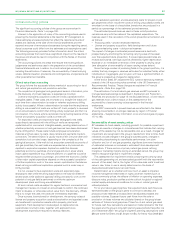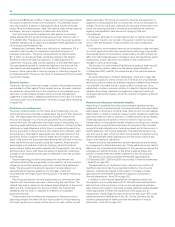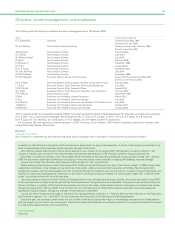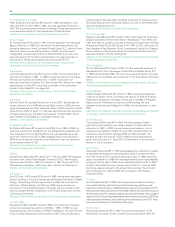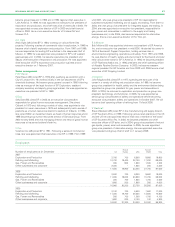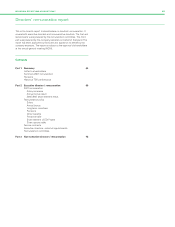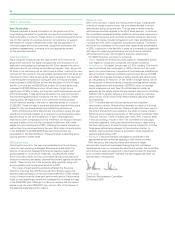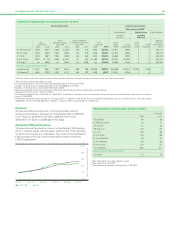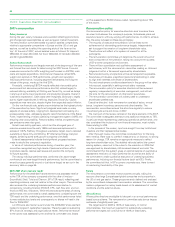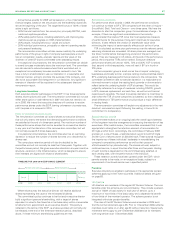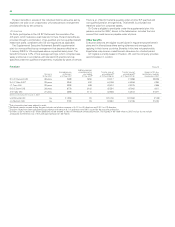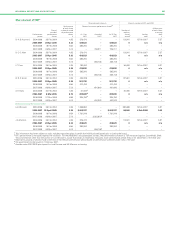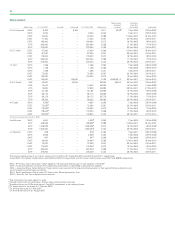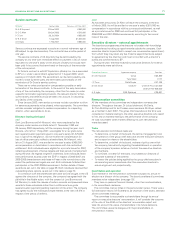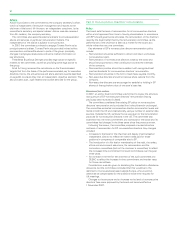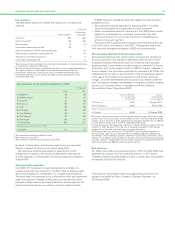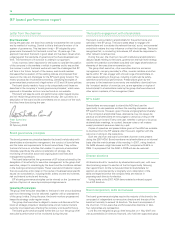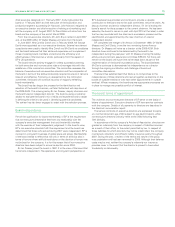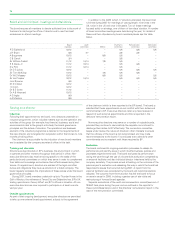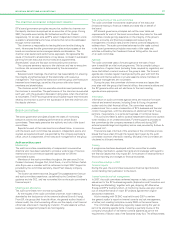BP 2007 Annual Report Download - page 69
Download and view the complete annual report
Please find page 69 of the 2007 BP annual report below. You can navigate through the pages in the report by either clicking on the pages listed below, or by using the keyword search tool below to find specific information within the annual report.
Annual bonus awards for 2008 will be based on a mix of demanding
financial targets, based on the annual plan and the leadership objectives
set at the beginning of the year. The target-level bonus of 120% of base
salary is split as follows:
– 50% financial metrics from the annual plan, principally EBITDA, cash
costs and capital expenditure.
– 25% safety performance, including satisfactory and improving key
metrics as well as progress on OMS implementation.
– 25% people, including behaviour, values and culture.
– 20% individual performance, principally on relevant operating results
and personal leadership.
The remuneration committee will also review carefully the underlying
performance of the group in light of company business plans and will
look at competitors’ results, analysts’ reports and the views of the
chairmen of other BP board committees when assessing results.
In exceptional circumstances, the remuneration committee can decide
to award bonuses moderately above the maximum level. The committee
can also decide to reduce bonuses where this is warranted and, in
exceptional circumstances, bonuses could be reduced to zero. We
have a duty to shareholders to use our discretion in a reasonable and
informed manner, acting to promote the success of the company, and
also to be accountable and transparent in our decisions. Any significant
exercise of discretion will be explained in the subsequent directors’
remuneration report.
Long-term incentives
Each executive director participates in the EDIP. It has three elements:
shares, share options and cash. The remuneration committee did not use
either share option or cash elements in 2007 and does not intend to do
so in 2008. We intend that executive directors will continue to receive
performance shares under the EDIP, barring unforeseen circumstances,
until it expires or is renewed in 2010.
Policy for performance share awards
The remuneration committee can award shares to executive directors
that will only vest to the extent that demanding performance conditions
are satisfied at the end of a three-year period. The maximum number of
these performance shares that can be awarded to an executive director
in any year is at the discretion of the remuneration committee, but will
not normally exceed 5.5 times base salary.
In exceptional circumstances, the committee also has an overriding
discretion to reduce the number of shares that vest or to decide that no
shares vest.
The compulsory retention period will also be decided by the
committee and will not normally be less than three years. Together with
the performance period, this gives executive directors a six-year incentive
structure, as shown in the timeline below, which is designed to ensure
their interests are aligned with those of shareholders.
TIMELINE FOR 2008-2010 EDIP SHARE ELEMENT
------------------------------------------------------------------------------------------------------------------------------------
2008 2009 2010 2011 2012 2013 2014
Performance period Retention period
ReleaseVestingAward
Where shares vest, the executive director will receive additional
shares representing the value of the reinvested dividends.
The committee’s policy continues to be that each executive director
build a significant personal shareholding, with a target of shares
equivalent in value to five times his or her base salary within a reasonable
timeframe from appointment as an executive director. This policy is
reflected in the terms of the EDIP, as shares awarded will normally only
be released at the end of the three-year retention period, described
above, if these minimum shareholding guidelines are met.
Performance conditions
For performance share awards in 2008, the performance conditions
will continue to relate to BP’s TSR compared with the other oil majors –
ExxonMobil, Shell, Total and Chevron – over three years. We have the
discretion to alter this comparison group if circumstances change – for
example, if there are significant consolidations in the industry.
We consider this relative TSR to be the most appropriate measure
of performance for the purpose of long-term incentives for executive
directors. It best reflects the creation of shareholder value while
minimizing the impact of sector-specific effects such as the oil price.
TSR is calculated as share price performance over the relevant period,
assuming dividends are reinvested. All share prices are averaged over
the three months before the beginning and end of the performance
period. They are measured in US dollars. At the end of the performance
period, the companies’ TSRs will be ranked. Executive directors’
performance shares will vest at 100%, 70% and 35% if BP is ranked
first, second or third respectively; none will vest if BP is in fourth or
fifth place.
As the comparator group is small and as the oil majors’ underlying
businesses are broadly similar, a simple ranking could sometimes distort
BP’s underlying business performance relative to the comparators. The
committee is therefore able to exercise discretion in a reasonable and
informed manner to adjust the vesting level upwards or downwards to
reflect better the underlying health of BP’s business. This would be
judged by reference to a range of measures including ROACE, growth
in EPS, reserves replacement and cash flow, as well as non-financial
reasons such as safety. The need to exercise discretion is most likely to
arise when the TSR of some companies is clustered, so that a relatively
small difference in TSR performance would produce a major difference
in vesting levels.
The remuneration committee will explain any adjustments in the next
directors’ remuneration report following the vesting, in line with its
commitment to transparency.
Special retention awards
The committee reviews on an ongoing basis the overall approriateness
of the long-term incentive arrangements in ensuring the retention of key
executives. After careful review, the committee considered that it was
appropriate to strengthen the retention element of remuneration for
Mr Inglis and Mr Conn. Accordingly, the committee in February 2008
granted, on a one-off basis, a restricted stock award to both Mr Inglis
and Mr Conn of shares worth £1,500,000 each. These awards recognize
the importance of these individuals’ leadership in re-establishing the
company’s competitive performance as well as their personal
attractiveness for top jobs externally. The shares will vest, subject to
continued service, in equal tranches after three and five years. Vesting
of each tranche is dependent on the committee being satisfied, at
each vesting date, with the performance of the individual.
These retention awards have been granted under the EDIP, which
permits awards to be made, on an exceptional basis, subject to a
requirement of continued service over a specified period.
Pensions
Executive directors are eligible to participate in the appropriate pension
schemes applying in their home countries. Additional details are given
on page 68.
UK directors
UK directors are members of the regular BP Pension Scheme. The core
benefits under this scheme are non-contributory. They include a pension
accrualof1/60thofbasicsalaryforeachyearofservice,uptoa
maximum of two-thirds of final basic salary and a dependant’s benefit
of two-thirds of the member’s pension. The scheme pension is not
integrated with state pension benefits.
The rules of the BP Pension Scheme were amended in 2006 such
that the normal retirement age is 65. Prior to 1 December 2006, scheme
members could retire on or after age 60 without reduction. Special early
retirement terms apply to pre-1 December 2006 service for members
with long service as at 1 December 2006.
BP ANNUAL REPORT AND ACCOUNTS 2007 67


